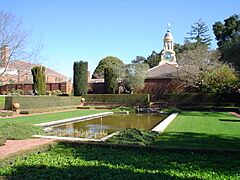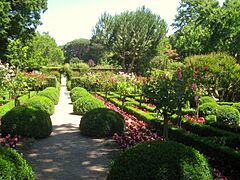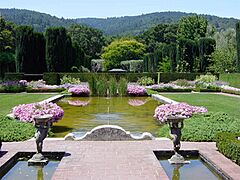Filoli facts for kids
Quick facts for kids Filoli |
|
|---|---|
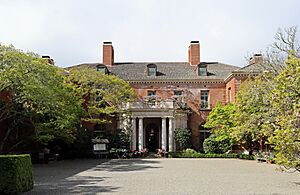
Exterior of Filoli, used as the Carrington Mansion on the television series Dynasty
|
|
| Location | 86 Cañada Road, Woodside, California |
| Built | 1915 |
| Built for | William Bowers Bourn II |
| Architect | Willis Polk |
| Architectural style(s) | Georgian Revival |
| Governing body | National Trust for Historic Preservation |
| Official name: Bourn-Roth Estate | |
| Designated | August 28, 1975 |
| Reference no. | 75000479 |
| Designated | February 8, 1977 |
| Reference no. | 907 |
| Lua error in Module:Location_map at line 420: attempt to index field 'wikibase' (a nil value). | |
Filoli, also known as the Bourn-Roth Estate, is a beautiful country house with large formal gardens. It is located in Woodside, California, about 25 miles (40 km) south of San Francisco. The estate covers 654 acres (265 hectares), with 16 acres (6.5 hectares) of stunning gardens. Filoli sits at the southern end of Crystal Springs Reservoir, on the eastern side of the Santa Cruz Mountains. Today, the National Trust for Historic Preservation owns Filoli, and it is open for everyone to visit. It is recognized as both a California Historical Landmark and a site on the National Register of Historic Places.
Contents
History of Filoli Estate
The Bourn Family Builds Filoli
Filoli was built between 1915 and 1917 for William Bowers Bourn II and his wife, Agnes Moody Bourn. William Bourn owned a very rich gold mine in California. He was also the president of the Spring Valley Water Company, which supplied water to San Francisco. The Bourns wanted a country home closer to their main house in San Francisco.
The main architect, Willis Polk, designed the house in a special style called Georgian. He also added tiled roofs, which are common in California. The gardens were planned between 1917 and 1922 by artist Bruce Porter and the Bourns. A horticulturist named Isabella Worn designed the plant arrangements and color schemes. She also looked after the garden for 35 years.
The Bourn family lived at Filoli from 1917 to 1936. The name "Filoli" is a special word made from parts of William Bourn's life motto. It stands for: "Fight for a just cause; Love your fellow man; Live a good life."
The Roth Family and Public Access
After William and Agnes Bourn passed away in 1936, the estate was sold in 1937. The new owners were Mr. William P. Roth and Mrs. Lurline Matson Roth. Lurline Roth was an heiress to the Matson Navigation Company. The Roth family added many beautiful plants to Filoli, like camellias, rhododendrons, and azaleas. They also built a peaceful swimming pool and a screened-in teahouse.
In 1975, Mrs. Roth gave the entire estate to the National Trust for Historic Preservation. She also provided money to help pay for Filoli's yearly running costs. This generous gift allowed Filoli to open its doors to the public.
In November 2023, Filoli hosted an important meeting between U.S. President Joe Biden and Chinese President Xi Jinping. This meeting happened during the 2023 APEC summit in San Francisco. Because of this meeting, many more people, especially from Asia, became interested in visiting Filoli. The estate was already popular with Asian tourists because its gardens and house appeared in the opening credits of the TV show Dynasty.
Managing Filoli Today
Filoli is run by the Filoli Center, which is a private, non-profit organization. It has its own board, staff, and many volunteers. In 2022, about 400,000 people visited Filoli.
The Filoli House
The main house at Filoli is very large, with 56 rooms and covering 54,256 square feet (5,040 square meters). It includes a ballroom, a reception room, a dining room, and family rooms. There were also separate rooms for the servants. When the National Trust received the house, it was empty. However, much of the original furniture and art has been given back. This helps to make the house look like it did when the Bourns lived there. This work is still ongoing. For example, in 2022, the gentleman's lounge was updated with new furniture and a recreation of the original wallpaper.
The Libraries at Filoli
Filoli has two libraries that hold information about the families who lived there and the estate itself. The Friends Library has about 1,500 books and many videos and oral histories. It also has copies of movies that were filmed at the estate. The Sterling Library is a research library with 1,800 books and 40 journals. Both libraries are only open to Filoli members or to people doing research.
The Beautiful Gardens
The 16 acres (6.5 hectares) of gardens are designed with many enclosed spaces. These spaces are surrounded by brick walls and neatly trimmed hedges. They open into each other, offering long views. The gardens mix many natural plants and flowers with green lawns, brick paths, and gravel paths. There are also formal reflecting pools, large terracotta pots, and tall Irish yew trees. Filoli is a great example of a gardening style that brought back formal Italian designs.
The gardens stretch southeast from the house up a gentle slope. The sunken garden is the first of four main areas. It has a rectangular pool in the middle with water lilies. This pool is flanked by two lawns and two olive trees, all within a hedge of trimmed Japanese yew. The walled garden has several smaller areas, including a design that looks like a stained-glass window made from trimmed boxwood.
Since the National Trust took over in 1975, Filoli has been open for public tours. Visitors can take self-guided tours, guided tours, and even nature hikes.
The formal gardens include special spots like the Wedding Place. This area is named after Berenice Roth's wedding, which took place there in 1941. Both Lurline and Berenice Roth had their wedding receptions at Filoli. However, Berenice's wedding was the only one held at Filoli when it was still a private home. The largest gardens are "working gardens." They grow cut flowers for the mansion and some vegetables.
The Orchard at Filoli
The Filoli Gentlemen's Orchard was started by the Bourn family in the early 1900s. However, the Roth family did not keep up the orchard, and by the 1970s, it was in poor condition. In 1997, the California Rare Fruit Growers began donating rare plants to help restore the orchard. Today, the orchard has over 650 trees. Many of these are rare types of fruit. This includes 275 kinds of apple trees, 59 pear varieties, 42 peach varieties, and 6 medlar trees, plus many more.
Nature and Conservation
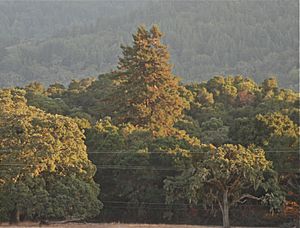
Laguna Creek, also known as "Orchard Creek," flows through the Filoli property. It starts on the western side of Edgewood County Park and flows northwest into the Upper Crystal Springs Reservoir. Its waters eventually join San Mateo Creek and flow into San Francisco Bay.
Historically, fish like coho salmon and steelhead trout used to swim up from the Bay into the San Mateo Creek watershed. In 1877, a dam was built on Laguna Creek, which stopped these fish from swimming further upstream into the creeks on Filoli. However, rainbow trout that live in the stream still swim up the creeks of Filoli from the reservoir to lay their eggs.
Historians have noted that there were large groves of redwood trees in the Laguna Creek area. There were also two historic lumber mills near Filoli. This suggests that the area was heavily logged in the past. A large redwood tree still stands on Laguna Creek near the lower Filoli parking lot.
Nature Trails at Filoli
Filoli has two nature trails behind its formal gardens: the California Trail and the Spring Creek Trail.
The California Trail
In 2017, Filoli opened The Estate Trail, a one-mile loop. This trail allowed visitors to walk through the natural areas of Filoli. In 2024, it was renamed The California Trail. This trail goes through a horse pasture, a field of native plants, and the former horse barn. It also crosses a bridge over Fault Creek and the San Andreas Fault, which runs through the property. The trail leads to a former barn that was turned into the Sally MacBride Nature Center. This center was later renamed the Lamchin Interpretive Center, in partnership with the Ramaytush Ohlone people.
The Spring Creek Trail
The new Spring Creek Trail opened in June 2024, located behind the Lamchin Interpretive Center. This trail climbs 125 feet and includes a new bridge over Spring Creek. It eventually leads to a man-made flume and pond where Mr. Bourn used to store water for his gardens.
Filoli as a Film Location
Filoli has been used as a setting for many Hollywood movies and TV shows. It is most famous for being the mansion seen from the air in the opening credits of the television series Dynasty. The inside of the mansion was also used in the first episodes of the show. Later, these rooms were recreated on sound stages. However, the entire mansion was used for the 2006 CBS Television special Dynasty Reunion: Catfights & Caviar. In this special, the cast members reunited and talked about their memories of the series. It was the first time many of them had been to the actual estate.
Many large, old trees on the grounds have appeared in films. A row of huge Italian Stone Pine trees and scattered Coast Live Oak trees, over 250 years old, were the background for Warren Beatty's outdoor scenes in Heaven Can Wait.
Filoli was also shown in Bob Vila's Guide to Historic Homes of America and in a November 1996 episode of A&E's America's Castles: Garden Estates. This episode is still shown at the visitor center.
The house was also used as the Stanhope residence in the 1997 film George of the Jungle. It was also featured in The Game in the same year.
Gallery
See also
 In Spanish: Jardín Filoli para niños
In Spanish: Jardín Filoli para niños
- National Trust for Historic Preservation – historic sites
- List of botanical gardens in the United States


